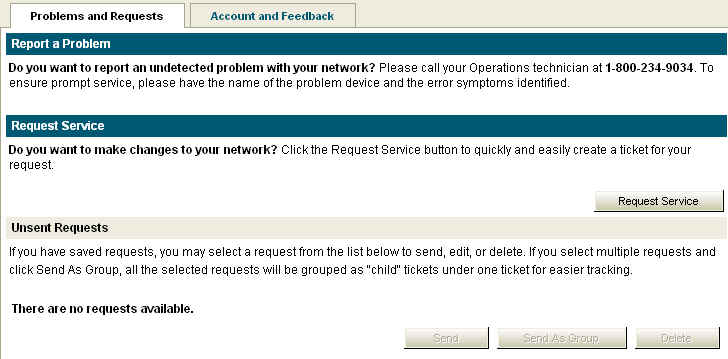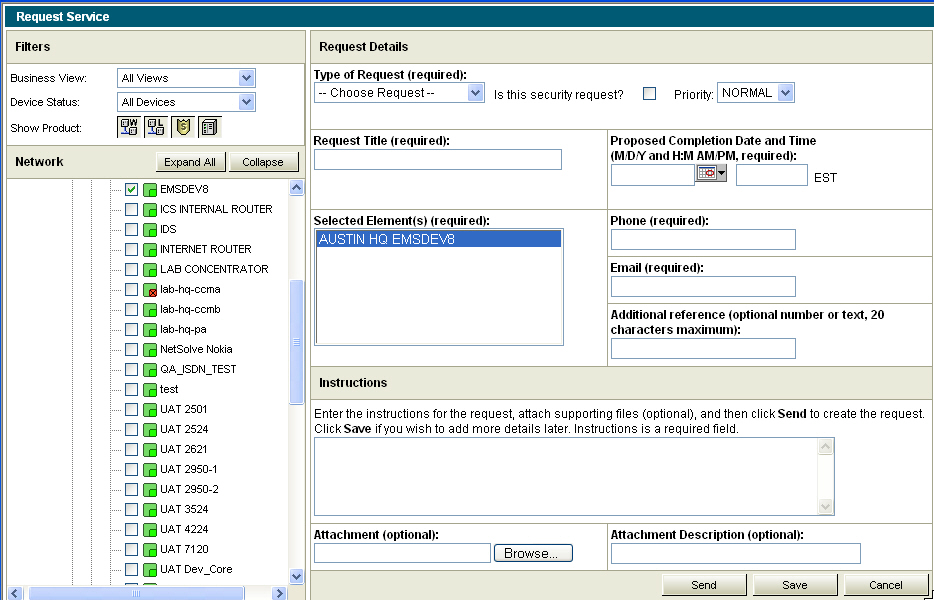
Submitting a request for service is the official way for you to ask Operations to make changes to your existing managed network. The changes can be related to the equipment in the network or to the services managing the network.
Example:

When you successfully submit a request, our system does the following:
Creates a work ticket containing your request information
Assigns the work ticket automatically to the appropriate owner on our team
Creates a confirmation screen showing the work ticket number you can use to track the work ticket
Examples of service requests include:
Add equipment/site
Move equipment/site
Change equipment
Remove or disconnect equipment/site
Change or update configurations
Port upgrade/downgrade
Add services
Other services
To request service:
Select the Support > Problems and Requests sub-tab. The Report Problem and Request Service window appears.
Click the Request Service button. The Request Service form opens in a separate window.
In the Network Tree, find the element(s) affected by the request for service. To select the element (device, location, or site) for the service, check the check box next to the element. The name appears in the Selected Element(s) box of the Request Service form.
NOTE: When adding a site or device, check the parent check box. For example, if you wanted to add a device to a Houston site, check Houston.
NOTE: You can select multiple elements within a network by repeating Step 3 as needed.
Example:

To select the Type of Request, select one of the options from the drop-down menu.
If the request regards security in a Managed Security Network, check the Is this security request? check box.
To select a Normal or Urgent priority for the request, click the Priority drop-down menu.
NOTE: If you select Urgent, you will be asked to confirm the selection because it impacts your service level agreement (SLA).
In the Request Title field, enter a name for the request.
By clicking the prompt button adjacent to the date field, enter the proposed completion date and time. A pop-up calendar opens with the current month shown.
Use the > scroll to advance to future months and the < scroll to return to previous months.
NOTE: The phone and e-mail fields automatically generate when the request opens, but you can manually update those entries by clicking in the data field and typing over the existing text.
To close the calendar, click away from the calendar area.
In the time field, enter a time, for example, 11:00 AM.
In the Phone field, enter a phone number.
In the Email field, enter the email address to which you want us to send a confirmation of our receipt of your service request. If you would like us to send e-mails to two or more different addresses, put a semi-colon and a space after each address.
The Additional reference field is an optional field that can hold a 20-character name or number to align with the customer tracking method. Click in the field to type any desired text.
In the Instructions detail area, enter any instructions, and attach supporting files (for example, configuration files). Use the Browse button to search for the files you want to attach. File attachments are limited to under 10MB.
NOTE: Following is a list of file extensions NOT ACCEPTABLE as file attachments. All uploaded attachments are scanned for viruses and put into your customer folder.
|
File Extension |
Description |
|
ADE |
Microsoft Access Project Extension |
|
ADP |
Microsoft Access Project |
|
BAS |
Visual Basic® Class Module |
|
BAT |
Batch File |
|
CHM |
Compiled HTML Help File |
|
CMD |
Windows NT® Command Script |
|
COM |
MS-DOS® Application |
|
CPL |
Control Panel Extension |
|
CRT |
Security Certificate |
|
EXE |
Application |
|
HLP |
Windows® Help File |
|
HTA |
HTML Applications |
|
INF |
Setup Information File |
|
INS |
Internet Communication Settings |
|
ISP |
Internet Communication Settings |
|
JS |
JScript® File |
|
JSE |
JScript Encoded Script File |
|
LNK |
Shortcut |
|
MDB |
Microsoft Access Application |
|
MDE |
Microsoft Access MDE Database |
|
MSC |
Microsoft Common Console Document |
|
MSI |
Windows Installer Package |
|
MSP |
Windows Installer Patch |
|
MST |
Visual Test Source File |
|
PCD |
Photo CD Image |
|
PIF |
Shortcut to MS-DOS Program |
|
REG |
Registration Entries |
|
SCR |
Screen Saver |
|
SCT |
Windows Script Component |
|
SHS |
Shell Scrap Object |
|
URL |
Internet Shortcut (Uniform Resource Locator) |
|
VB |
VBScript File |
|
VBE |
VBScript Encoded Script File |
|
VBS |
VBScript Script File |
|
WSC |
Windows Script Component |
|
WSF |
Windows Script File |
|
WSH |
Windows Scripting Host Settings File |
NOTE: A request can be saved once all required fields have been completed. Required fields include Selected Elements and Instructions. The request is listed by Customer Name and can be opened for editing by clicking on EDIT in the listing under Unsent Work Requests.
To submit the request, click Send. A response appears showing the work ticket number corresponding to the request.
NOTE: If you want to wait to send the request, click Save.
Examples of Service Requests:
WAN: Add equipment/site
Move equipment/site
Change equipment
Remove or disconnect equipment/site
Change or update configurations
Port upgrade/downgrade
Add security services
IPT Change
Services: Phone Changes Network Changes
Add Phone Add or Delete a Switch
Delete Phone Add or Delete a Blade
Setup Voice Mail Add Voice Circuit
Delete Voice Mail Routing Change
Change Name Other Changes
Change Privileges
Phone Number Change
Other Changes
Security
Services: Firewall Service
Service Updates
IP Address Translation (NAT/PAT)
Route Changes
Hardware/Software upgrades
Request Configuration Review
Access Policy Review
Firewall Log host Data Inquiry (Data Management Service Customers Only)
VPN Updates
Network Intrusion Detection System Service (NIDS)
Host Intrusion Detection System Service (HIDS)
Related topics:
Working with Network Operations
Tracking an Open Service Request (Work Ticket)
Viewing a Closed Service Request (Work Ticket)